Bell pepper is a wonderful tasty and healthy vegetable that you can ...

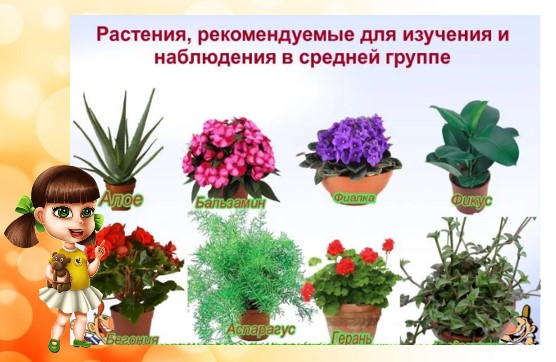
MDOU "TsRR-d / s No. 104"
Abstract
"Caring for indoor plants"
Compiled by: I.S. Vitushkina
Educator of the highest category
Magnitogorsk, 2015
Topic: "Caring for indoor plants"
Software content
Develop an interest in indoor plants
Teach children to outline a sequence of labor actions based on diagrams, motivating ways of performing, depending on the nature of the surface of the leaves, strength, quantity and size. \ For example: the sheet is large, hard, smooth, durable, rarely located - so you can wipe it with a cloth \
Continue teaching children to describe the plant, identifying differences and similarities in characteristic features; Draw conclusions and conclusions based on the examination of objects \ look, touch, examine in a magnifying glass \
Strengthen children's ideas about different ways plant care. Develop logical thinking, imagination \ using animation \ memory \ memorize the algorithm of labor actions for cleaning any plants from dust, depending on the nature of the leaves, using schemes \
Strengthen the ability to work with different kinds plant care tools \ rag, sprayer, brush.
Foster a desire to care for plants. The desire to bring the work started to the end \ the teacher's assessment of the volume and quality of work, the teacher's encouragement \.
Vocabulary work: ficus, dracaena, cactus, violet,
Preliminary work:
1. Physical education "Flowers";
2. Conversation about houseplants;
3. Reading poems and riddles about plants;
Equipment: aprons for children and educators, oilcloth, flower pots, watering cans, rags, spray guns, dust brushes; a letter with a riddle; spatula, loosening sticks.
Course of the lesson:
A knock on the door: The postman brought a letter from Dunno.
Children: Want to know what's in it?
Mystery: "The air is purified, they create coziness
They turn green on the windows and bloom in winter ”(Answer: flowers)
Slide number 1 room plants
Educator: In the letter Dunno asks to help him. He says that his flowers are sick and he does not know how to help them. Can we help him save his flowers?
Educator: In order to begin salvation, let's consider: What does a flower have? (This is the stem of the leaves, the bud).
And what is in the ground? (The root of the flower is in the ground).
Slide number 2 showing the scheme of the plant
Educator: Children, do you think a plant can live without a root?
Children's answers: Can not
Educator Why?
Children's answers: The plant will fall, cannot eat - it will die
Educator: Indeed, the root is an important part of the plant; it holds the plant, nourishes it. No root - no plant! Guys, do you want to see how the plant drinks water?
\ displaying experience with a plant root \.
Educator: now I suggest you turn into different, beautiful flowers.
Physical education "Flowers grow in the meadow"
Flowers grow in the meadow
Of unprecedented beauty... (Stretching - arms to the sides.)
Flowers reach out to the sun.
Stretch with them too. (Stretching - arms up.)
The wind blows sometimes
Only it doesn’t matter. (Children waving their hands, imitating the wind.)
The flowers are leaning
The petals are lowered. (Tilts in., Hands down.)
And then they get up again, And they still bloom.
Educator: Guys, what should be done so that the plants always delight us with their lush greenery, bright bloom?
Children: It is necessary to take care of them: water, wipe the leaves, loosen the ground.
Educator: Guys, look, are the same plants on our table?
Educator That's right, flowers differ from each other in appearance, because they have a different shape of leaves, stem, color. Since the plants are different, then the care for them should be different. And to help us learn how to take care of flowers, the flower care semes compiled by you ... Educator invites the children to come to the table, on which are laid out cards with conventional images \ leaves of different orders and configurations, tools \ there is an easel nearby.
Educator: Masha, please show us Ficus, choose cards that are suitable for caring for Ficus.
Educator: Egor, did Masha choose the cards correctly?
Educator Tell me how to take care of Ficus according to the scheme drawn up by Masha.
Educator: If Ficus leaves are large, smooth, tough, then what method should be used to remove dust from the leaves?
Child: put a leaf of the plant on the palm of your hand and gently wipe it with a cloth from the stem to the end of the leaf, loosen the ground, water it.
Educator: Who removes the dust from the leaves? Person. So, which card is missing in our scheme?
Educator: So that a person does not stain his clothes in the process of his work, what does he need for this? \ apron diagram /
Slide number 3 tools for caring for flowers
Slide 4 of the plant care sequence diagram
Educator: Who will draw up a care scheme for dracaena?
Educator Who will tell you according to the scheme how to care for dracaena?
Educator: That's right, they need to be sprayed, because it has narrow leaves, and it is difficult to wipe with a cloth, loosen the ground, water. Slide 5 of the plant care sequence diagram
Educator: Guys, who remembers what leaves the Violet has and how to care for it?
Children: Violet's leaves are small, fragile, fluffy.
Educator: You can wipe them with a cloth, like a ficus ?
Educator That's right, from the leaves of the violet we will gently sweep the dust with a brush, we can damage the hairs, and the leaves of the violet are also afraid of water. Slide 6 of the plant care sequence diagram
Educator: Look guys, this flower has no leaves, but only one trunk, and that one is covered in thorns
What is this flower? - Cactus
Educator: Who will draw up a cactus care scheme.
How do you know if this plant needs lipolysis?
Children: it is necessary to touch the ground with your hand, if the ground is wet, it is not necessary to water.
Slide 7 of the plant care sequence diagram
Educator: who has yellow stickers - he goes to look after dracaena;
who has blue stickers - he is caring for a violet;
who has green stickers - he cares for Ficus
Children start work after putting on aprons.
Educator: Guys, what do you think is necessary for the life of a plant
Slide number 8 of the scheme - soil, water, heat, light
Educator: Well done, guys.
Do our flowers have soil? - yes, we loosened it up, the roots of the plant breathe; We watered the plant,.?
Is there enough light and warmth for the plant?
Well done, guys, did a good job! In response to your care, the plants will always delight you with juicy green leaves, bright colors... Will fill clean air Dunno's room. I will send him flowers and your schemes so that he does not forget to properly care for the flowers.
Educator: What did we do today? For what? What new have you learned?
Plants in a group kindergarten, in addition to the aesthetic, they also have a number of educational and educational functions. Children learn to care for plants, understand the relationships in nature, and take responsibility.
When designing an appropriate corner of nature in a group, the following requirements must be strictly observed:
Specific tasks, types of plants, are spelled out in educational program... For example, in the main "Program of education and training in kindergarten" edited by M.A. Vasilyeva (hereinafter the Program), which is chosen as a priority by more than 50% of preschool institutions, gives a clear description of the responsibilities of preschoolers and the tasks of educators in certain age groups. In our article we will rely on this particular Program.
The program prescribes:
While the acquaintance of children with plants occurs at the simplest level. Children learn to recognize several types of plants by their characteristic features (leaf shape, color, smell), to distinguish between their parts (stem, leaf, flower).
From the age of three, children are actively involved in caring for plants. Educators pour water into watering cans. Kids learn to properly hold watering cans, water plants in a kindergarten group, wipe large plants with a damp cloth.
At this age, preschoolers are attracted to vivid views... For a corner of nature, they choose for a long time flowering plants, such as: common geranium, ficus, fuchsia, ever-flowering begonia, camellia, Chinese rose, balsam. The number of species does not exceed three or four.
The program prescribes:
From the age of 4, children learn to see a variety of properties and qualities. They already more easily distinguish the features of plants, understand the processes that are necessary for the life of flowers.
Helping children is becoming more structured. They learn to water plants in a kindergarten group from a fine mesh watering can, to spray with a spray bottle, to clean dropped leaves with a dry brush, and leaves with a damp cloth or a serrated brush. Preschoolers are already able to independently determine whether a plant needs watering or not, based on the color of the ground (if the ground is dry, water it, if the ground is dark, the plant does not need watering).
To the variety of plant species from last year's group are added: aloe or agave, begonia rex, fragrant geranium, zonal geranium, asparagus.
The Program prescribes:
The knowledge of children is becoming more in-depth. Preschoolers are told what is needed for the growth of a plant, which can lead to its death. Children learn to determine how to care for plants based on appearance stem and leaves. New topic- reproduction of plants vegetatively, with the help of stem cuttings.
Five years is the age at which a child can take care of plants on their own, without a teacher's advice.
Since last year, some of the plants have been distributed to parents or given to a younger group. At the same time, their place can be taken by plants with various stems (creeping, climbing), having bulbs: tradescantia, climbing ivy, cactus, cyclamen, primrose, amaryllis, clivia, indoor grapes.
The program prescribes:
Children are told about the seasonality of plants, about the main stages of their growth and development, about the laws of reproduction using leaf cuttings.
Plants are added to the corner that are fundamentally "opposite" in their needs: a cactus and an uzambara violet on the one hand (plants that do not need constant watering), and papyrus, tradescantia, primrose - on the other hand (plants that need constant watering) ...
Greetings, dear readers of my blog! I am with you again, Tatiana Sukhikh! All parents dream of their child being in kindergarten in the same healthy microclimate as at home. To provide such an environment, it is necessary to acquire vegetation. With the help of them, it is possible to create coziness in the room, as well as to establish the aesthetic side. Indoor flowers in a group can act not only as an interior item, but also as an element of a living corner in the life of children. One of my readers asked why it is impossible to put indoor flowers in a preschool educational institution?
The fact is that among these "pets" there are prohibited varieties that can be very dangerous to the health of the child. Based on the principles of choosing indoor flowers for kindergarten, you can create a beautiful, and most importantly, safe green corner. Children will be interested not only in the process of acquaintance with specific types of vegetation, but also in learning how to properly care for them, because the surrounding atmosphere is very important for good health and full development.
List of prohibited plants:
By the way, in order to organize a beautiful and interesting corner for children in the garden, quite a few types of plants will do. We bring to your attention the most popular of them:

In order to facilitate the work of preschool educational institutions, each of these establishments must have a passport of indoor flowers. I have given you an approximate list with the names of the most successful specimens, which will be a winning option for decorating a green corner.
In the process of organizing a green and blooming corner, you need to show responsibility and a serious approach. For this purpose, it is imperative to adhere to a number of principles:
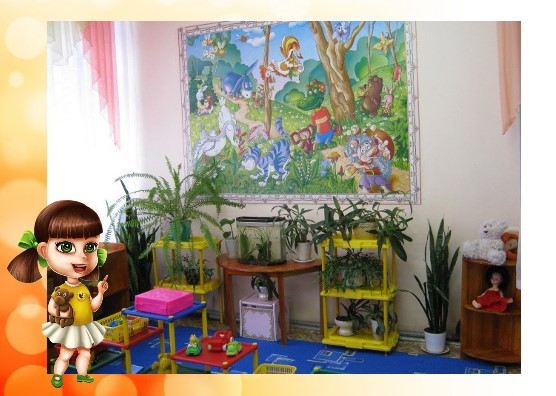
Each preschool institution must have a card index with photos and pictures of permitted and prohibited types of indoor flowers. I suggest you buy the book http://www.labirint.ru/books/382261/, which presents subject illustrations of flowers and their models for caring for them.
For each individual group in kindergarten, plants must be selected individually. For example, if size and brightness are important for the smallest, then for older children such types will be ideal, which they will look after together with teachers at the preschool educational institution, joining in this exciting activity.
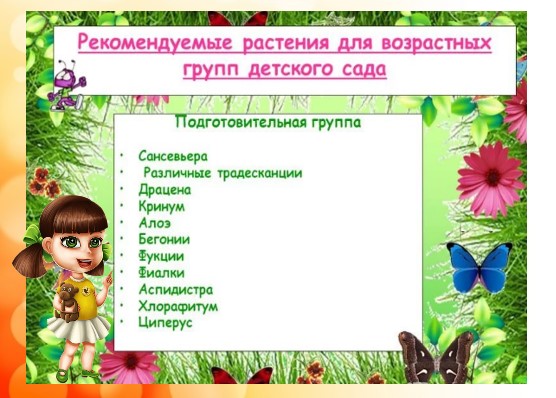
A handy guide that can be used for independent activities of little people in play forms, in any class. Each illustration is accompanied by a description, poems, riddles, spelling of Russian and English words. Using the text of the card index, children can compose a story with details according to the description http://www.uchmag.ru/estore/e274864/?partner=61.
How to properly care for plants, how they feed and reproduce, which of them are edible and which are not, why they need to be pollinated https://book24.ru/product/rasteniya-169131/?partnerId=915020.
That's all for this, dear visitors to my blog! Tatiana Sukhikh was with you! Don't forget to share useful material and be sure to subscribe to updates. There will be a lot more interesting things for you!

Best regards, Tatiana Sukhikh! Till tomorrow!
Group No. 4
Presentation made by: teacher MBDOU No. 27 "Zhuravushka"
Shilova Irina Vladimirovna

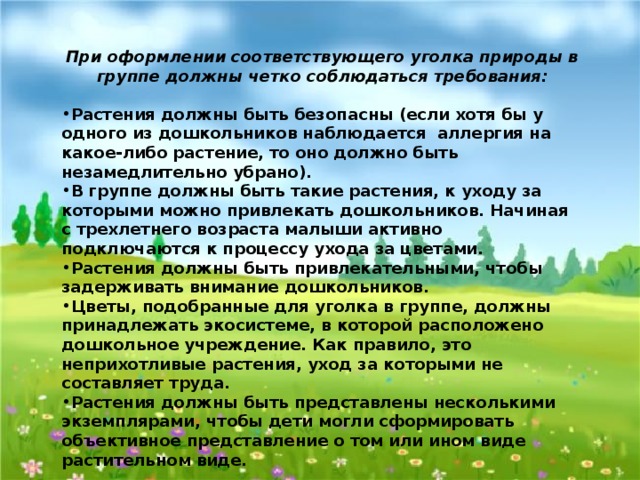
When designing an appropriate corner of nature in a group, the following requirements must be strictly observed:
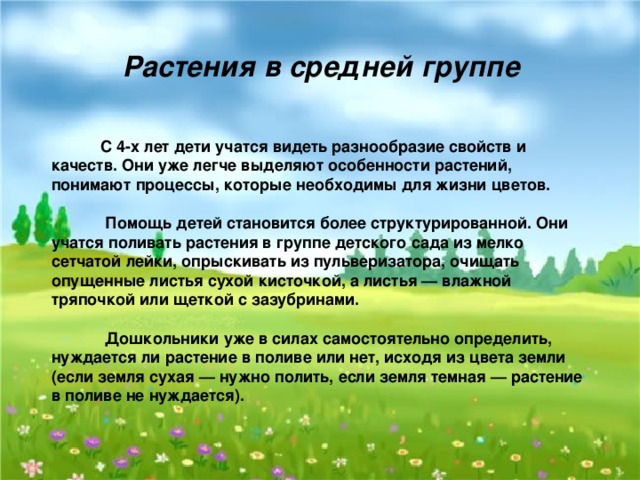
Plants in the middle group
From the age of 4, children learn to see a variety of properties and qualities. They already more easily distinguish the features of plants, understand the processes that are necessary for the life of flowers.
Helping children is becoming more structured. They learn to water plants in a kindergarten group from a fine mesh watering can, to spray with a spray bottle, to clean dropped leaves with a dry brush, and leaves with a damp cloth or a serrated brush.
Preschoolers are already able to independently determine whether a plant needs watering or not, based on the color of the earth (if the ground is dry, you need to water it, if the soil is dark, the plant does not need watering).
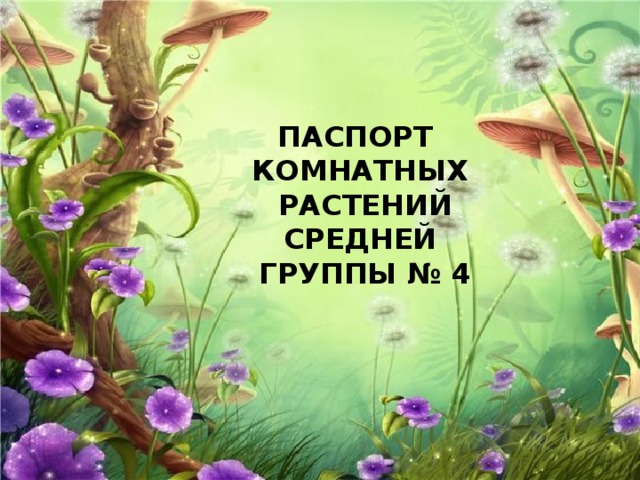
THE PASSPORT
ROOM
MEDIUM PLANTS
GROUPS No. 4

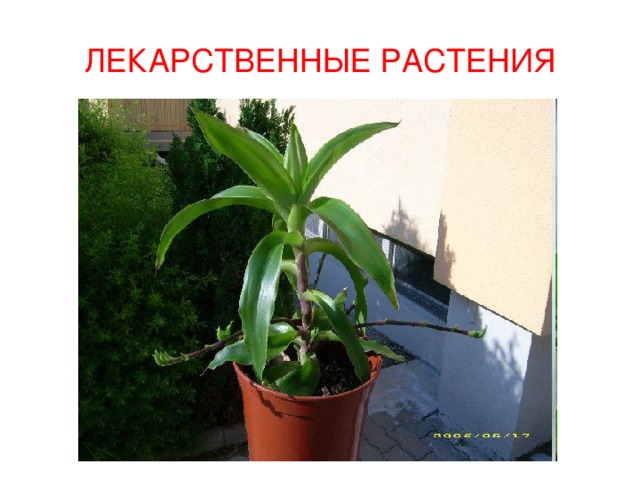

Symbols
Attitude to
light
Penumbra
Diffused light
Direct rays
Watering
drying the earth
Sump water level
Permanently wet ground
Light drying of the earth
Washing under the shower
Regular spraying
Brushing
Leaf care
Wiping
damp cloth
Endurance
K apricious
Into the hardy
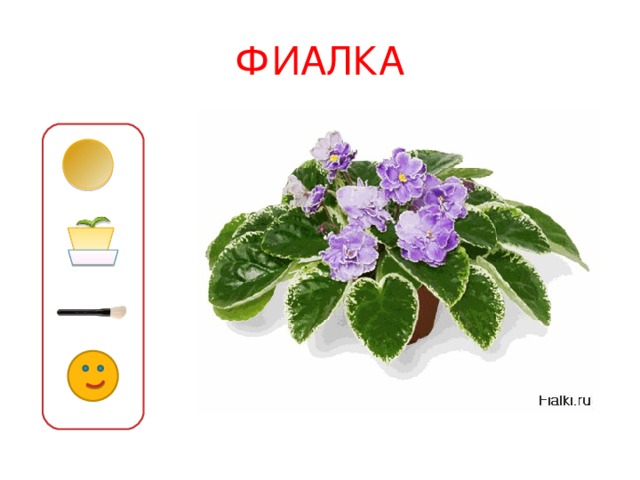
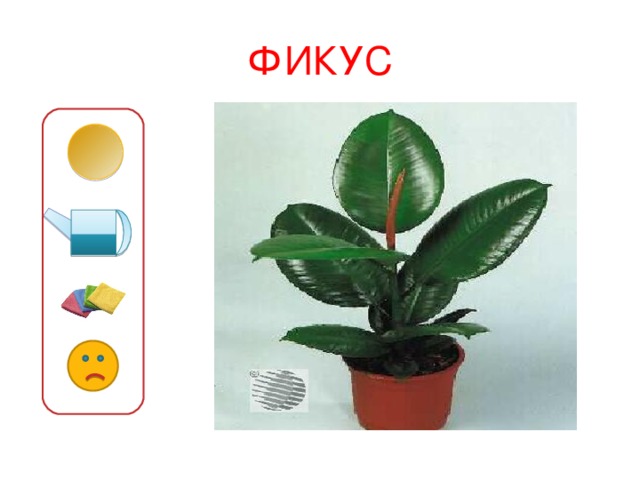




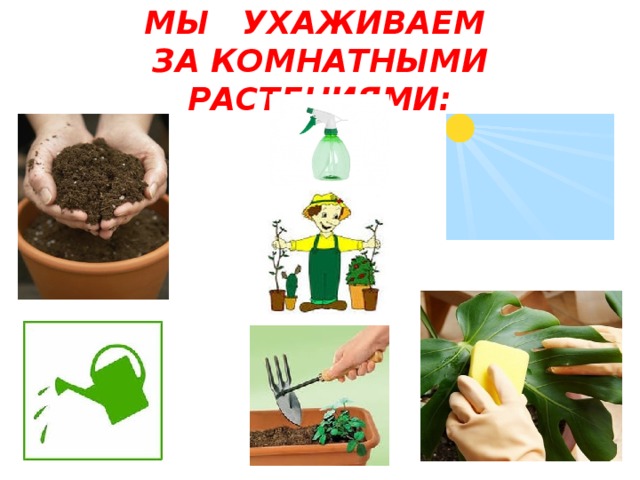
WE CARE OUTSIDE PLANTS:
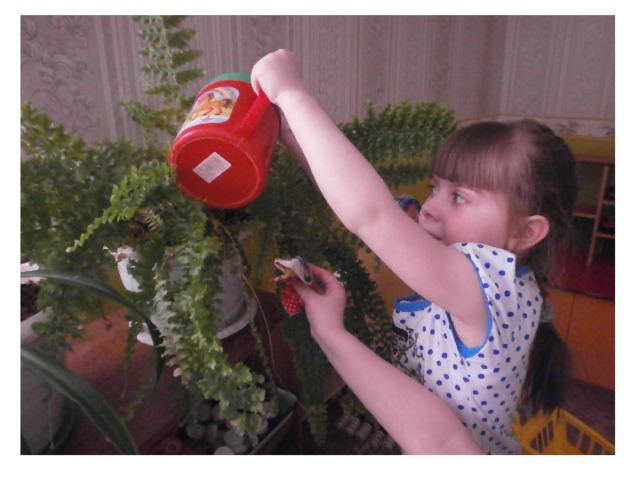

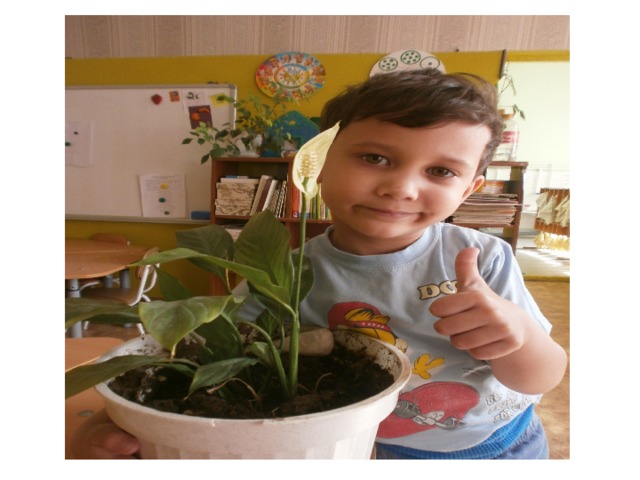
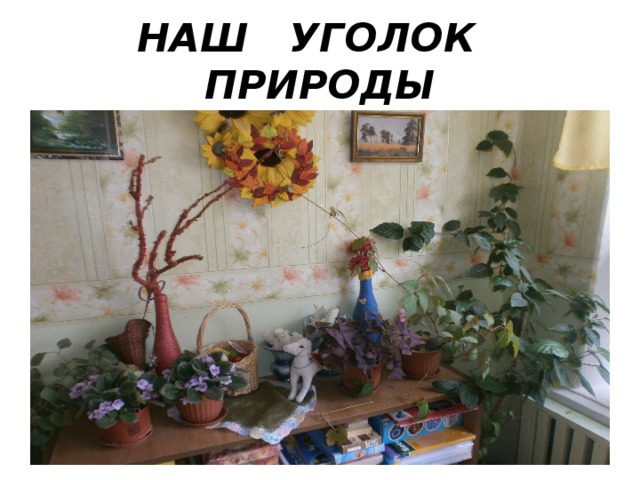
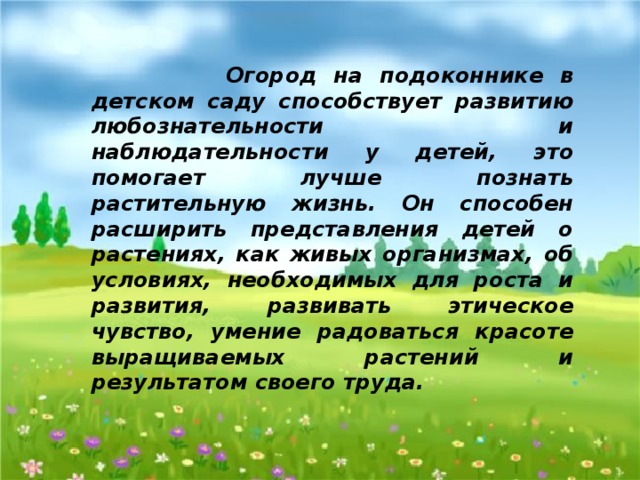
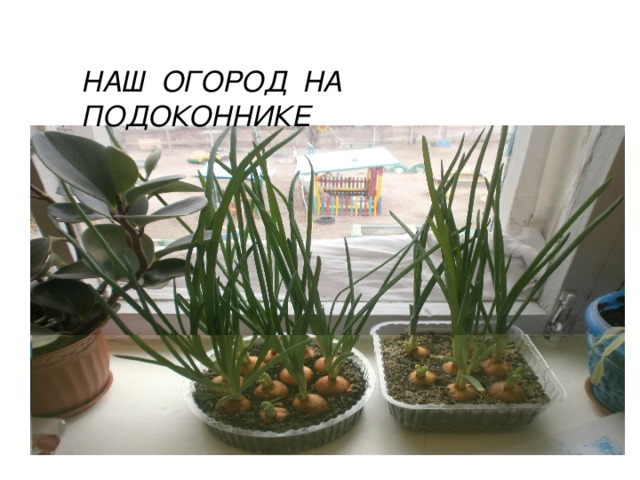
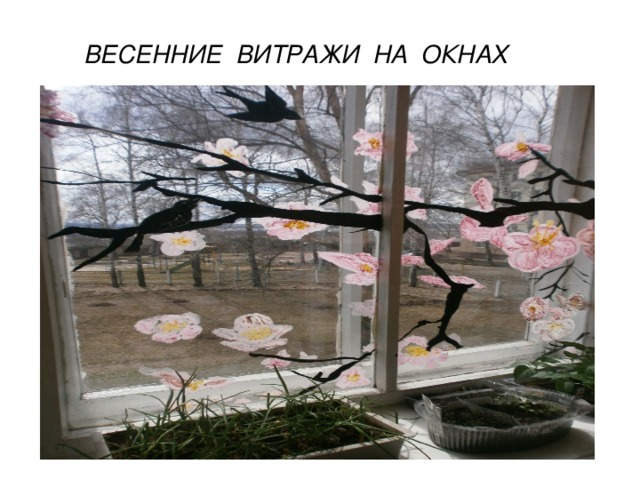
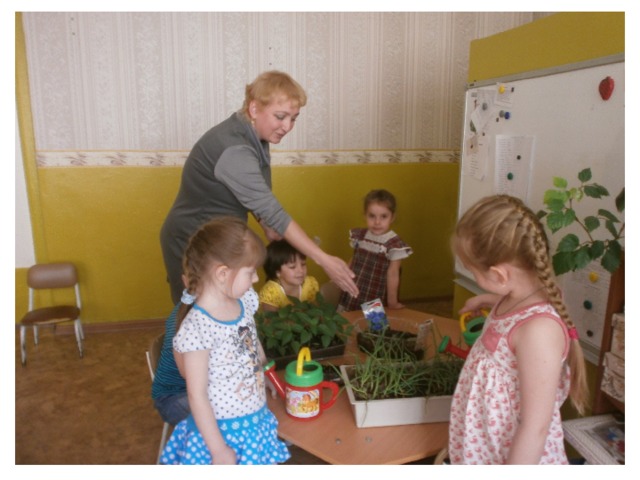
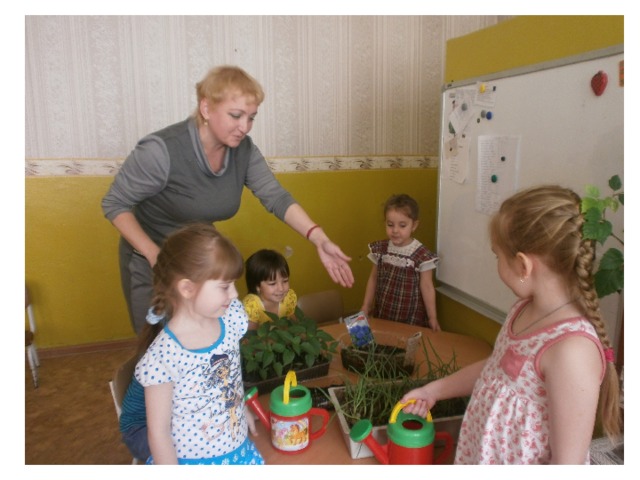

Such work develops observation skills, teaches you to carefully peer into surrounding nature, establish the sequence and connection of phenomena, their causes.
Growing, caring for plants, the guys observe which of them grow faster, compare the shape and color of the leaves, examine them through a magnifying glass, determine the conditions necessary for the growth and development of plants, so this is also an excellent consistent material.
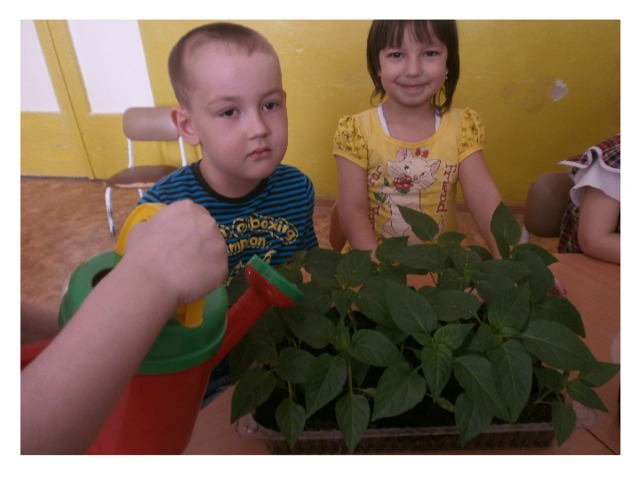
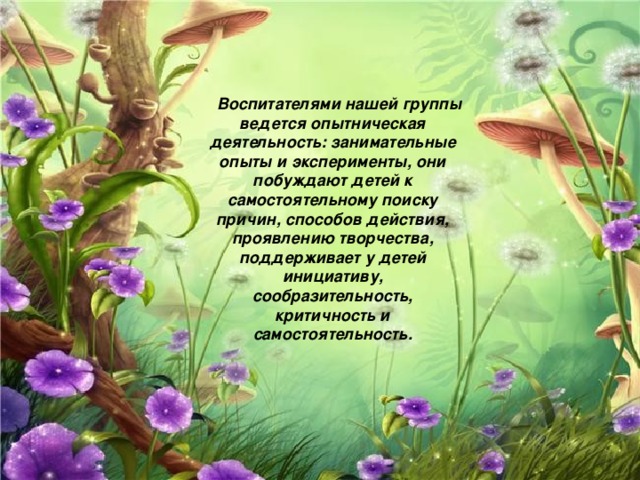



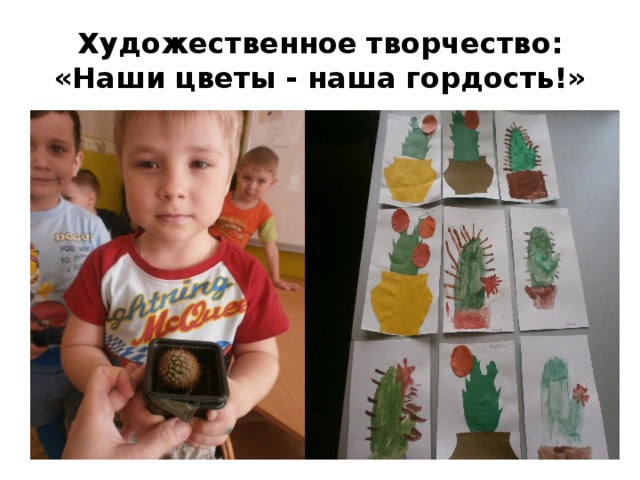
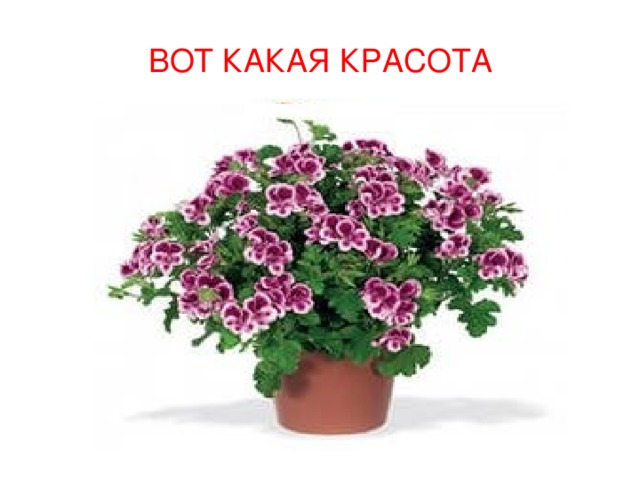
MKDOU CRR Kindergarten number 31 "Altn Bulg"

Prepared by: Oltsaeva Valentina Aleksandrovna, teacher of the middle group No. 1 "Harada"

Morpho is a biological characteristic of indoor plants in a corner of nature in the middle group.
Ficus
WITH  family of mulberry. This is one of the most common indoor plants. First place of honor among different types of ficuses is occupied by Ficus rubbery or Ficus elastica. Also very popular are Ficus Benjamin, Ficus lyre, Ficus Bengal, Ficus dwarf, etc.
family of mulberry. This is one of the most common indoor plants. First place of honor among different types of ficuses is occupied by Ficus rubbery or Ficus elastica. Also very popular are Ficus Benjamin, Ficus lyre, Ficus Bengal, Ficus dwarf, etc.
All ficuses do not tolerate drafts, waterlogging of the soil and direct sun (ficuses of variegated forms are more photophilous, they tolerate direct sun, but shading is needed during the hottest hours).
In winter, the ficus also needs light, so the pots with plants are rearranged closer to the window. And variegated forms, for example, ficus benjamin, can stand all winter even on the south window. With a lack of lighting in winter, weak and curved shoots and leaves are formed.
Ficuses are propagated by cuttings. From a shoot, you can get as many cuttings as there are leaves on it. The propagation stalk should consist of one leaf with an intact eye and half of the lower internode without an eye. After cutting the cutting, it is immersed in warm water to stop the release of milky juice. For better rooting, a cut or split is made at the bottom of the cutting (for a cutting with hard wood, crosswise, for a cutting with soft wood, one cut). It is better to root the cuttings with soil heating and cover the cutting with a plastic bag.
For all ficuses, this is best suited soil mix- 2 parts of leaf, 1 part of peat land and 1 part of humus. Ficuses do not like being planted in a bowl much larger than theirs. root system, therefore, transplant them when, presumably, the roots fill the entire pot or tub. At the same time, they grow quite quickly, therefore, the soil during transplantation should be nutritious, in addition, fertilizing fertilizing is carried out in spring and summer (they respond well to feeding organic fertilizers, well suited for this rotted cow dung or store fertilizer "Giant"). Ficuses can also be fed with such fertilizers as "Rainbow" and "Palma". Old specimens of large ficuses are transplanted very rarely - after 5-6 years. But can be replaced annually upper layer land on a new one. It is also necessary to replace the top layer of the earth if a white crust appears on it - a salt deposit.
Temperature: preferably moderate, not lower than 18 ° C. They like to "keep their feet warm" - do not put the ficus pot on a cold windowsill, marble or tiled floor, etc. In a room with temperatures above moderate, the leaves begin to hang down.
Lighting: All varieties of rubber ficus prefer a bright place, protected from direct sun rays... Variegated forms need a lighter and warmer place than forms with dark leaves.
Watering: Moderate, does not like waterlogging. Water at room temperature, well settled. Top dressing with fertilizers from March to August in two weeks.
Air humidity: Leaves should be regularly wiped with a damp sponge.
Transfer: They are carried out in the spring, when the roots cover the entire earthen lump, young plants in a year or two, old plants in a few years.
Reproduction: Apical cuttings, for better rooting with heating the soil and covering the cutting with a plastic bag.
Fuchsia
WITH  family of primrose plants. Homeland Central and South America, New Zealand... These are eternally green shrubs, of which there are about 100 species in nature.
family of primrose plants. Homeland Central and South America, New Zealand... These are eternally green shrubs, of which there are about 100 species in nature.
Fuchsia graceful Fuchsia gracilis is a shrub with reddish stems. Leaves are opposite, oval-lanceolate, 4-5 cm long, pointed at the end and slightly toothed along the edge. Flowers drooping on long stalks. The fruits are black berries. Flowering begins in spring, and fuchsia flowers are short-lived, but they are quite numerous and flowering at favorable conditions abundant.
Many different varieties of fuchsia exist and continue to appear in culture, which are difficult to describe. Fuchsias differ in the shape and structure of flowers - simple, double, semi-double and their colors- white, pink, red, purple, purple, etc. Unfortunately, fuchsia is a rather short-lived plant, as it is very demanding on temperature conditions and begins to shed its leaves at the end of flowering.
CARE TIPS
Temperature: Moderate or cool throughout the year, at temperatures above 18-20 ° C, fuchsia sheds flowers and leaves, until the plant dies. In winter, not lower than 6 ° C, fuchsias prefer a cool overwintering at a temperature of 8-10 ° C.
Lighting: Fuchsia is very photophilous, while the light should be diffused; from direct sunlight, fuchsia can get burns. Fuchsia will grow well on eastern windows.
Watering: In summer it is plentiful, the soil should be slightly damp all the time. In winter, watering is moderate or limited, depending on the temperature. At insufficient watering fuchsia sheds buds and flowers.
Fertilizer: From March to September, fuchsia is fed with mineral fertilizer for flowering indoor plants.
Air humidity: In the summer, fuchsia is periodically sprayed. On hot summer days, you can place the plant on a pallet of wet pebbles.
Transfer: Annually in the spring. Soil - 3 parts of clay-sod and 2 parts of peat land with the addition of 1 part of sand. It is better to drain in a pot or tub.
Reproduction: Stem cuttings in spring or summer, which are rooted with the use of rooting stimulants (heteroauxin, root).
Ever-flowering begonia
WITH  family of begonias. There are many types of begonias and they are all beautiful in their own way. Among begonias, there are both decorative leafy and decorative flowering species. Begonias are beautiful houseplants with juicy leaves that have a somewhat lopsided shape. On the pedicels there are both male and female flowers... In female flowers, a trihedral is formed above the petals seed capsule... Most begonias bloom all summer long, but when they are created good conditions, they can bloom in autumn and even in winter. All begonias are divided into two main groups: decorative leafy begonias and decorative flowering begonias.
family of begonias. There are many types of begonias and they are all beautiful in their own way. Among begonias, there are both decorative leafy and decorative flowering species. Begonias are beautiful houseplants with juicy leaves that have a somewhat lopsided shape. On the pedicels there are both male and female flowers... In female flowers, a trihedral is formed above the petals seed capsule... Most begonias bloom all summer long, but when they are created good conditions, they can bloom in autumn and even in winter. All begonias are divided into two main groups: decorative leafy begonias and decorative flowering begonias.
Decorative blooming begonias
Valued for the beauty and abundance of their flowers. Among decorative blooming begonias there are evergreens that can be kept in indoor conditions throughout the year, for example, ever-flowering begonia. Some of the most spectacular blooming begonias are tuberous begonias, which are potted crops such as the Lorrain begonia hybrids and the Elatior begonia hybrids. These plants, after flowering, finish their growing period and, as a rule, are thrown away. Tuberous begonias bloom in summer and autumn (when good care from spring to December), in the winter they lose their leaves. In autumn, when tuberous begonias begin to go into a dormant state, watering is reduced, and after the leaves fall off, they stop altogether. The tubers are freed from the ground and stored in boxes in the sand, in a cool room. During the wintering of tubers in a room, in pots, they are watered from time to time, but avoiding dampness.
Caring for decorative flowering begonias
Temperature: Moderate temperatures above 20 ° C are undesirable for these begonias. Winter temperatures are around 17-18 ° С, but not lower than 15 ° С.
Lighting: Bright illumination, s compulsory protection from direct sunlight during hot times of the day. During flowering, begonias should stand on the windows not crowded, so that one flower does not obstruct the other. To maintain proper growth, they are periodically turned on the windows.
Watering: Abundant in spring and summer, but do not flood. begonias do not like stagnant water, as well as drying out of an earthen coma. The water should be soft, settled. Tuberous potted begonias are not watered in winter, they are stored in a dry peat substrate.
Air humidity: Begonias love high humidity, but do not tolerate spraying. Practice has shown that almost all types of begonias react to the ingress of moisture on the leaves with the appearance of brown spots. Therefore, in hot, dry weather, you can place begonias pots on a tray or box of wet peat or moss.
Transfer: In early spring the tubers are planted in fresh soil. Rhizome begonias are transplanted as needed, when the pot is already cramped. Nutrient soil - a mixture of humus, leaf and sod land with the addition of a small amount of coniferous soil and river sand. At the same time, the earth is not filled up to the top, so that later, when additional roots are formed, it would be possible to fill up the earth. Plants are placed on a sunny window and they quickly become covered with new leaves, and after about 40-50 days, buds appear.
Fertilizer: It is useful to fertilize decorative flowering begonias from the moment the flower buds are formed with a liquid complex fertilizer for flowering indoor plants once every two weeks. Do not use nitrogenous fertilizers on ornamental foliage as this will lead to leaf growth and suppression of flowering.
Reproduction: Propagated by stem cuttings and seeds. Tuberous begonias in addition, they multiply by dividing sprouted tubers. The tuber is cut in half, so that each part has sprouts and roots, the cuts on the tuber are sprinkled with charcoal or sulfur. The nodules are planted so that its top does not rise much above the soil level.
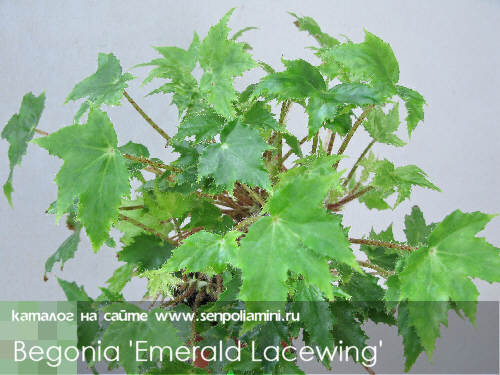
Caring for ornamental leafy begonias
Temperature: Moderate, optimally 18-20 ° С, in winter not lower than 16 ° С. Royal begonias hybrids prefer a temperature slightly higher than optimal 22-25 ° C.
Lighting: Bright lighting, with mandatory protection of direct sunlight. It is desirable that the lighting is uniform. all year round... To do this, in the summer, begonias are slightly moved away from the window (but the place should be very bright), and in winter they are moved as close as possible to the window.
Watering: Abundant in spring and summer, but do not flood. begonias do not like stagnant water, as well as drying out of an earthen coma. In winter, watering is moderate, on cloudy, gloomy days, when there is very little light, watering is stopped altogether. Begonias are watered very carefully so that the stream of water does not fall on the leaves, otherwise brown spots remain on them. The water should be soft, settled. Between October and March, begonias are watered more moderately. From March to October, fertilizing is carried out once a week, using liquid complex fertilizers for decorative deciduous plants.
Air humidity: Begonias require high humidity air. But bush begonias, for the most part with leaf puffing, do not tolerate the ingress of water on the leaves, so you can place the pots of begonias on a tray, or in a box with wet peat or moss.
Transfer: Annually or every other year, in the spring. In a cramped pot, begonia leaves turn pale and lose their decorative effect. Nutrient soil - a mixture of humus, leaf and sod land with the addition of a small amount of coniferous soil and river sand. Begonias prefer soils that have a slightly acidic reaction, when the pH is 5.5 - 6.5. After transplanting, the plants are pruned.
Reproduction: Stem cuttings, leaves, part of the leaf, division and seeds. The stems are cut into pieces 2 cm long and placed in bowls for rooting, preferably with soil heating.
Balsam ("light")
WITH 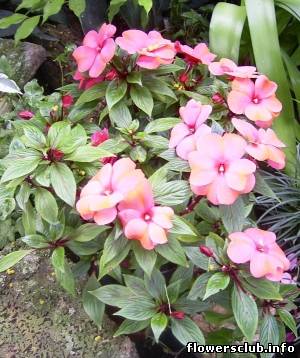 family of balsamines. The homeland of balsam is tropical and subtropical Asia and Africa. More than 500 species of these herbaceous, bushy plants are known in nature. Translated from the Latin impatiens is translated as "intolerant", so Balzamin got the name of touch-me-not. This is due to the fact that the ripe fruits of this plant, at the slightest touch, open and seeds fly out of them.
family of balsamines. The homeland of balsam is tropical and subtropical Asia and Africa. More than 500 species of these herbaceous, bushy plants are known in nature. Translated from the Latin impatiens is translated as "intolerant", so Balzamin got the name of touch-me-not. This is due to the fact that the ripe fruits of this plant, at the slightest touch, open and seeds fly out of them.
Balsam has many names. The people call him Lizzy, a busy man or Vanka wet. The first name appeared in connection with the ability of this plant to bloom almost all year round. Vanka wet balsam was christened for its moisture-loving nature, with a lack of moisture in the soil, the plant's stems and leaves immediately droop.
Impatiens Waller Impatiens walleriana - up to 55-60 cm tall, with erect juicy stems. The leaves are alternately arranged, broadly oval, pointed at the end, light green in color and finely toothed along the edge. Leaves up to 10 cm long, flowers about 4 cm in diameter, single or in few-flowered inflorescences with long pedicels. Flowers can be red, pink, white, reddish-orange, or red-white. This species is the starting point for many hybrids and varieties, which can have different color of leaves, color and structure of the flower (simple or double, one or two colors).
Impatiens Peters Impatiens petersiana - from 60 cm and above, with erect red stems. Differs in rapid growth. The leaves are lanceolate, purple-red in color, finely toothed along the edge, on long petioles.
Impatiens linearifolia - fast-growing plants, bush sizes up to 1 m, with erect reddish stems. Leaves are narrowly oval, pointed at the end, finely toothed along the edge. The leaf surface is green with a wide creamy stripe in the center and a reddish central vein.
Impatiens Canvas Impatiens holstii - from 60 cm and above, with erect stems. Leaves are ovoid, pointed at the end, finely toothed along the edge. The leaf surface is brownish green.
In all of the above species, flowers can be of a wide variety of colors and colors, white, pink, red, purple, white, purple, lilac, purple, monochromatic or two-color, simple or double.
SECRETS TO SUCCESS:
Temperature: Moderate, in winter
not lower than 12 ° С. For flowering in winter, the temperature must be at least 15 ° C.
Lighting: Photophilous, but in summer you need to shade from direct sunlight.
Blooming in winter requires several hours of direct sunlight daily.
Watering: Abundant, the soil should always remain moist. In winter, watering is reduced.
Air humidity: From time to time, it is useful to spray the leaves, avoiding water getting on the flowers.
Transfer: It blooms well only when the roots fill the pot.
If necessary, transplanted in the spring.
Reproduction: Stem cuttings at any time of the year or seeds in spring.
Chinese rose tree
WITH 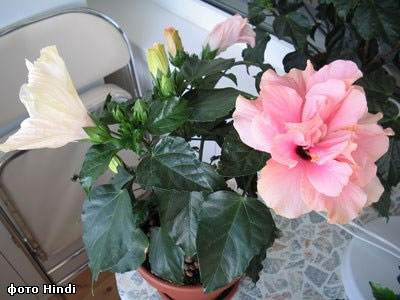 family of malvaceae. Evergreen shrub, at home from 70 to 1.2 m tall. Blooms quite easily with good care with large flowers up to 12 cm in diameter. Flowering can be very abundant and long - from spring to autumn, although the flowers do not last long - about two days. Flowers come in different shades - orange, yellow red, pink or white, as well as different shapes- simple or terry. There are varieties with variegated leaves. In the summer, it is better to take the plant out into the garden, but the place should be protected from the wind and a little darkened.
family of malvaceae. Evergreen shrub, at home from 70 to 1.2 m tall. Blooms quite easily with good care with large flowers up to 12 cm in diameter. Flowering can be very abundant and long - from spring to autumn, although the flowers do not last long - about two days. Flowers come in different shades - orange, yellow red, pink or white, as well as different shapes- simple or terry. There are varieties with variegated leaves. In the summer, it is better to take the plant out into the garden, but the place should be protected from the wind and a little darkened.
CARE TIPS
Temperature: Hibiscus is quite thermophilic. In summer, they are kept at a temperature of about 20-25 ° C. In winter, at 15-20 ° С, at least 13 ° С.
Lighting: Light-requiring, prefers bright diffused light, with a small amount of sunlight. In winter, you need a bright room. The best place for hibiscus is in the east or west window. The south window will need shading during the hottest hours of the day.
Watering: Abundant from spring to autumn. The soil should be moist at all times. Moderate in winter. Avoid waterlogging or overdrying the earthy coma. Do not use cold water.
Fertilizer: From April to August, hibiscus is fed with special complex fertilizers for flowering indoor plants, every 3 weeks. You can use "Rainbow", "Ideal", etc.
Air humidity: Sprayed regularly.
Transfer: Soil - 1 part sod, 1 part leaf, 1 part peat land, 1 part sand. Transfer in March - April. Pruned after transplant. And in the summer, you can pinch it repeatedly. Spacious dishes are preferable. In the spring, the plant is shortened and transplanted into fresh soil.
Reproduction: Stem cuttings, which are best rooted in July-August.
Asparagus
WITH  family of asparagus. Homeland tropical and subtropical regions of the Old World. It is divided into semi-climbing species - pinnate asparagus and ampelous species - Sprengeri asparagus. Fern-like asparagus with subulate "leaves" are common as indoor plants. Asparagus pinnate Asparagus plumossus is a compact plant with graceful, spreading young age branches that eventually become bare below. The smallest cultivar is Asparagus plumossus Nanus. Asparagus densiflorus sprengery has hanging shoots with bright green "leaves" and red berries. Less common, but more decorative is Meyer's Asparagus Asparagus meueri. Straight and tough, densely pubescent "leaves" shoots reach 40-55 cm in length and effectively set off plants with large leaves in compositions. Asparagus crescent Asparagus falcatus is not at all like a fern. It has large, heart-shaped "leaves" and thorny stems reaching one meter in length. Asparagus asparagus Asparagus asparagoides is a branchy shrub with creeping stems that reach 1.7 m in length. Two common asparagus - pinnate and dense-flowered - are valued for their graceful openwork branches. Despite popular belief, they are not ferns, and their silky "leaves" are actually modified stems.
family of asparagus. Homeland tropical and subtropical regions of the Old World. It is divided into semi-climbing species - pinnate asparagus and ampelous species - Sprengeri asparagus. Fern-like asparagus with subulate "leaves" are common as indoor plants. Asparagus pinnate Asparagus plumossus is a compact plant with graceful, spreading young age branches that eventually become bare below. The smallest cultivar is Asparagus plumossus Nanus. Asparagus densiflorus sprengery has hanging shoots with bright green "leaves" and red berries. Less common, but more decorative is Meyer's Asparagus Asparagus meueri. Straight and tough, densely pubescent "leaves" shoots reach 40-55 cm in length and effectively set off plants with large leaves in compositions. Asparagus crescent Asparagus falcatus is not at all like a fern. It has large, heart-shaped "leaves" and thorny stems reaching one meter in length. Asparagus asparagus Asparagus asparagoides is a branchy shrub with creeping stems that reach 1.7 m in length. Two common asparagus - pinnate and dense-flowered - are valued for their graceful openwork branches. Despite popular belief, they are not ferns, and their silky "leaves" are actually modified stems.
In general, asparagus is an unpretentious plant.
CARE TIPS
Temperature: Moderate to cool, for most asparagus around 15-18 ° C. Winter minimum 10 ° C, ideal 10-14 ° C.
Lighting: Photophilous, the best place sill of the north-east or north-west window. If the plant is placed in a room, behind a tulle curtain, then its place is near the east or west window; if the window is south, then in the room at some distance from the window. In winter, more diffused light is needed, the plants are rearranged closer to the window.
Watering: In winter (from November to February), watering is moderate, in spring it is increased. In summer, you can leave water in the trays.
Air humidity: Loves wet air, sometimes asparagus does not bloom just because the air is too dry. If the plant is close to the battery central heating or a fireplace, then small leaves begin to turn yellow and crumble, and spraying will not help here, you will have to rearrange the plant away from the source of hot air.
Transfer: Asparagus requires spacious dishes and light nutrient soil from leafy, greenhouse and clay-soddy soil with sand. Young plants are transplanted annually in spring, old ones every 2-3 years. When transplanting, you should not damage the root system unnecessarily, but if the roots have grown very violently, then you need to carefully cut off the nodules with your hands, so that the root system decreases three times. During the period of active growth, fertilizing fertilizing is carried out.
Reproduction: Sowing (March-April) seeds that ripen easily and dividing the bush. When dividing, the plant is carefully knocked out of the pot. Divide into 3-4 parts so that each has at least one aerial shoot. Fertilizing weekly watering in summer promotes strong growth and abundant flowering... It is best to rejuvenate old plants with dried shoots by dividing the rhizomes after pruning.
Aspidistra
WITH 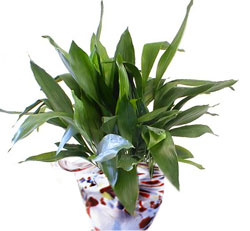 family of liliaceae. Homeland Japan. 8 species are widespread in nature. Aspidistra high Aspidistra elatior is grown in culture - perennial herbaceous plant... She has an underground creeping rhizome, glossy leaves on long petioles, broadly oval or lanceolate, about 50 cm long and 15 cm wide. At the base of the leaf you can see 1 or 2 reduced leaves encircling the petiole. The flowers are small, purple in color, appear under the leaves on short legs.
family of liliaceae. Homeland Japan. 8 species are widespread in nature. Aspidistra high Aspidistra elatior is grown in culture - perennial herbaceous plant... She has an underground creeping rhizome, glossy leaves on long petioles, broadly oval or lanceolate, about 50 cm long and 15 cm wide. At the base of the leaf you can see 1 or 2 reduced leaves encircling the petiole. The flowers are small, purple in color, appear under the leaves on short legs.
CARE TIPS
Temperature: Develops well in moderate conditions. In winter, it requires coolness, preferably no higher than 15 ° C, optimum temperature 10-12 ° C, minimum 5 ° C. If kept in winter at temperatures above 20 ° C, regular spraying is required.
Lighting: In summer, shade from direct sunlight, light partial shade. In winter, the aspidistra needs good lighting.
Watering: Abundant from spring to autumn, moderate or rare in winter, depending on temperature.
Fertilizer: From April to September every two weeks they are fed with a special liquid fertilizer for indoor plants.
Air humidity: Aspidistra only tolerates dry air if it is not too greasy. However, regular spraying and washing of the leaves only has a beneficial effect on the plant.
Transplant: Since aspidistra does not tolerate a transplant, it is transplanted as needed - after 3-4 years, in the spring. The soil is a mixture of sod land (2 parts), leaf (1 part), humus (1 part), peat (1 part) and sand (1 part).
Reproduction: In the spring, dividing the bush during transplantation. Aspidistra can also be propagated by a leaf, using a special technology. It lies in the fact that the aspidistra is cut off healthy leaf without a petiole, so that a thick fleshy ridge at the base of the leaf (formed by reduced leaves like a sheath) is preserved. Then the leaf cut is dried and placed in a bottle of water (a bottle with a wide neck, like kefir). The bottle is closed with a lid and covered with plasticine so that air does not get there. The bottle is placed in a warm and bright place. When roots appear on the leaf cut, it is taken out and planted in loose (preferably leafy) soil and covered with a jar or placed in a room greenhouse. If the roots did not appear, and the end of the leaf began to deteriorate and decay, then you can cut it off to healthy tissue (only in the place of thickening of the leaf) and put it back in the bottle in clean water.
Fragrant geranium
WITH 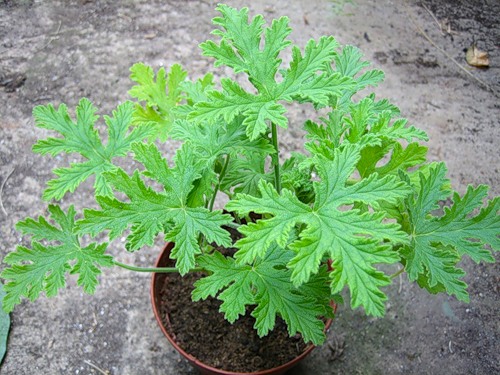 family: Geraniums, Geraniaceae.
family: Geraniums, Geraniaceae.
Origin: South Africa, some species from the Mediterranean.
Flowering time: May-October, some species all year round.
The genus Pelargonium (geranium) includes about 250 species. Over time, five large groups: decorative deciduous; fragrant; noble or English; ivy, or balcony geranium; zoned or standing geranium. Pelargonium fragrant has healing properties.
Lighting: Bright and sunny.
Watering: Abundant as the soil dries up. Waterlogging should be avoided. Watering less often in winter. During the growth period, weekly feeding.
Temperature: Moderate, preferably outdoors in summer. In winter, at least 10 ° C.
Reproduction: Cuttings.
Pests, diseases: White-tailed, aphid; zonal or "standing geranium" - aphids, spider mites, gray rot, "rust"
Content:
Ficus
Fuchsia
Begonia ever-flowering and speckled
Balsam (light)
Chinese rose tree
Asparagus
Aspidistra
Fragrant geranium